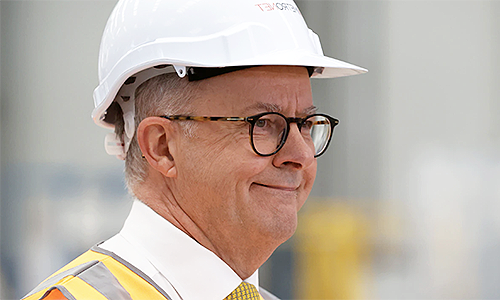
by ROGER CROOK – ANTHONY Albanese’s agency tasked with delivering a $10b affordable housing fund for low-income families paid more than $24m to external consultants and $6m in annual executive salaries last year, despite not having yet delivered a single completed house.
This is according to an article written by Simon Benson in The Australian newspaper on June 4.
- Australia needs 640,000 homes for people experiencing homelessness.
- The price of houses double and then double again and we never considered the consequences.
- The mortgage crisis is real; defaults are increasing and expected to continue to rise.
That is Australia in 2024. That is what Australian governments, State and federal, have not achieved over the past 30 of 40 years – houses for Australians.
They have not only failed to build housing for our most vulnerable; they have failed to build houses for our young people who are the future of our country.
CRISIS
Over the past few decades the ever-increasing housing crisis has been caused by governments of all persuasions ignoring that it is the “right” of every person in the land to have a roof over their head; a place, which they can call home; dry and secure, a place from which they can grow.
We have watched on as successive Federal Treasures smile as skilled migrants brought money into the country and make the national accounts look good.
We accepted the claims of Josh Frydenberg, Scott Morrison and now Jim Chalmers and all the treasurers who went before them, that young migrants offset an ageing population and would help pay for our retirement; and they made the national accounts look good.
We believed governments when they told us that with new migrant labour productivity improves, and that businesses support the availability of a ready source of skilled and unskilled labour.
Now, in 2024 we are told, as if we didn’t already know it, there is not only a shortage of houses, but also a shortage of affordable houses.
“Everybody’s Home” is a Labor initiative. It is, they say, a people’s commission intent upon giving individuals and organisations across Australia an opportunity to contribute to a national conversation about the housing crisis, its impacts and what can be done about it.
The People’s Commission recently received 1500 survey submissions which showed:
- Three in five (58%) respondents are in housing stress.
- Three in four (76%) of those who rent are in housing stress.
- The top ways respondents are coping with housing costs are by reducing energy use like heating or cooling their homes (52%), avoiding the doctor and essential appointments (45%), and reducing vehicle use (39%)
- Uncertainty about the future (67%) and increased housing costs (61%) are the top reasons for concern about the housing crisis. (Source CHIA June 2024.)
Rent and housing stress is when more than 30% of disposable income is spent on rent or mortgage.
None of the above statistics should come as a surprise. Tales that “Foodbank” is constantly running short of supplies are numerous; that it is not only the demonstrably poor who are looking for help with feeding the family is concerning.
The mortgage crisis is real; defaults are increasing and expected to continue to rise.
Most young couples cannot get within a bull’s roar of an $800,000+ purchase in a major city, outer suburb; especially if they need two cars just to get to work.
So, they rent and try to save; they don’t have children, because little ones will interfere with their plans for their future.
ANXIOUS
When they realise the time to have a family has nearly passed, they get anxious and then, too often, they separate.
If it’s a marriage, it’s a statistic, if it’s not, it’s just another tragedy of life for the young people of Australia today.
We are all responsible for the hearts of our young people being damaged and broken; we elected the governments who caused the trauma.
We watched the price of houses double and then double again and never considered the consequences; except for ourselves and our retirement.
The result is evident in our society. To compensate, our disillusioned young ones buy a new 4WD ute with big spotlights and a bull bar, a fridge in the back, a pair of red recovery (bog) mats and a tent.
Then they go surfing or camping at weekends, just to get away and try to forget that they will not achieve what mum and dad achieved, unless they win the lottery.
I recently wrote how a world war and dire necessity can be the mother of invention. We learned that state-of the art bombers were built in an hour; cargo ships built in a few days and battle ships from keel laying to commissioning in less than a year.
Ordinary people responded to a national crisis by training and gaining new skills and then performed extraordinary deeds; their expertise and the synergism their effort created, defeated strong enemies.
No new houses were built during the Second World War, even though as early as 1942 the ALP had the prescience to form the Department of Post-War Reconstruction, those wise men knew what was coming.
Ben Chifley was the minister in charge and his right-hand man was that well-known figure from the Whitlam years, HC (Nugget) Coombs.
The population of Australia in 1945 was 7.3m, about a quarter of what it is today.
In 1946, nearly 500,000 military personnel were demobbed and were back in the Australian workforce, ready and willing to re-build Australia. Five hundred thousand, does that number ring a bell? Migrants perhaps?
Between January 1945 and March 1949, the people of Australia built 132,000 houses across this wide brown land: providing homes for six hundred thousand people. (Just over four people per household in those days. Today the figures are about 2.5 people per household.)
In the ten years between 1945 and 1955 the population of Australia grew from 7.3m to 9.3m.
EVERYONE
In those ten years the people built more than 600,000 houses; the vast majority were privately owned and realised Bob Menzies dream for everyone to own their own home.
The Australians of the nineteen fifties were a stalwart lot; they had survived World War II. Many had lived through and suffered the deprivations of the Great Depression, unemployment, hunger and then the Spanish Flu, a pandemic which killed thousands.
For so many it was only 30 short years after the raw anguish, the absolute horrors, and the unimaginable losses in World War I of men, women and boys of many nations including Australia.
The Australians and the New Australians of the 1940s and 50s had lived through conditions, which most people these days only see on television.
What they see today in Gaza, was Liverpool or Dresden, the Coventry, the Ruhr Valley and the Darwin and Broome of the 1940s.
In 1948, just like today, there was a need for skilled migrants and, exactly like today, there was nowhere for them to live; and to make matters worse, again eerily like today, there was a shortage of building materials.
A team of Australian designers and architects met the challenge of the time and set about helping to solve the post-war housing shortage; they configured a complete house that could be flat packed.
They commissioned companies in England to build these kit homes; at the same time with more than a touch of inspiration and entrepreneurial flair, they trained committed migrants in Britain in the skills needed to construct their new home, in Australia.
Operation Snail was born: “Migrants with a house on their back.”
By 1949, Operation Snail was delivering forty houses a week together with the people to erect them. Snail houses were not boxes either, they were 2, 3 or 4 bedroom houses, all pre fitted with the mod cons of the day; even a laundry.
It is estimated that across three States more than 5000 snail houses were erected before the scheme was stopped due to domestic politicking.
Another scheme aimed at keeping costs to a minimum in those post war years, was a collaboration between the Royal Institute of Architects and The Age newspaper.
Melbourne architect Robin Boyd was the brains behind the scheme. Boyd and his colleagues designed houses which were quite small, but which could be added onto quite easily as the needs demanded.
Together with the Small Homes Service, a government department, Boyd and others offered a range of plans, which were published in The Age and obtainable by anyone for about $300 in today’s money (Five pounds then).
HANDYMAN
The plans were specially designed so that any builder could work with them, and which any handyman could understand.
What an innovation a modern version of Operation Snail would be today. Migrants who could come to Australia providing they brought their Australian designed house with them!
There is technology available today – computers, CAD systems and robotics – which I believe could build a house in a factory in a few hours; and have it on the back of a truck and on site within a day, maybe less.
This is not new technology. Nearly every new house in Sweden is built in a factory. In America, modular construction is meeting the demand for houses, as it is the UK.
If our ancestors could assemble 250,000 parts and construct a heavy bomber in an hour, surely today’s generation could do that with a house; a structure which doesn’t have four engines and have to fly on completion!
Our young need to accept that their first house will not be a palace. It will be a starter home. It may be small and designed to be enlarged when needed; all this has been done before.
We need a national effort to establish factories; factories to build a houses every hour, twenty four hours a day seven days a week. Can it be done? We will never know until we try.
This government needs to get on with the real task and forget about millions of our dollars for quantum computers, solar panels, hydrogen and renewable energy; they need to build houses for the people – more than 600,000 of them.PC













Found a captivating read that I’d like to recommend to you http://gazeta.ekafe.ru/viewforum.php?f=48
Let’s be practical. A lot of housing issues could be solved by long term caravan parks, trailer parks, modular and prefabricated homes. Modular and prefab homes are built in a factory and assembled onsite. Much quicker and cheaper to build than regular homes and could be assembled by the thousands in estates. In don’t understand why there is a shortage of housing and this sort of practical solution isn’t considered. Better than living in a tent. Its called “starting at the bottom” where people used to start in the good old days.
“Let’s be practical. A lot of housing issues could be solved by long term caravan parks, trailer parks, modular and prefabricated homes.”
LOL – have you heard of a little thing called “immigration”?
Do you know that a lot of violent criminals in South Western Sydney are not Australians, but were allowed to come here from overseas? Do you remember what happened at the Lindt cafe, and who was responsible? Do you know that if you live in Melbourne and come from a particular country overseas you are *178 times* more likely to be charged with having committed a violent criminal offence? Do you know that we have had Sikhs and Hindus brawling in public in Melbourne?
You think that my two hard-working sons, who are of outstanding character, should have to live in caravans so that we can accommodate floods of foreigners such as those? It’s clear that you have an IQ that is low enough to make you a potential political candidate (you might even qualify as someone who could run for the Greens).
‘Our young need to accept that their first house will not be a palace.’
That is part of the problem. A workmate was trying to sell his home several years ago; he’d come to work with stories about showing young potential buyers around, and copping the most absurd comments. ‘Oh, there’s no tv in the main bedroom’. ‘Oh, there’s no dishwasher in the kitchen.’
The term ‘spoilt brats’ comes to mind.